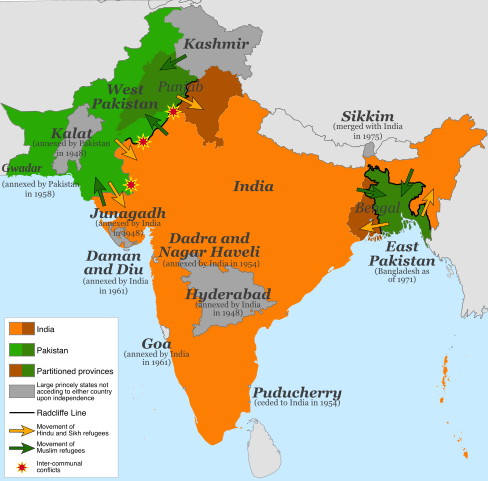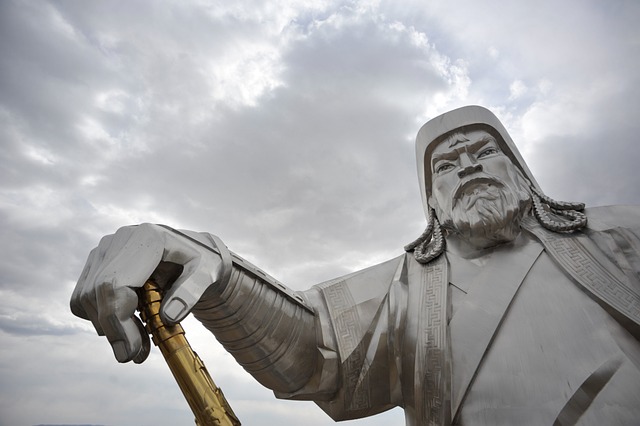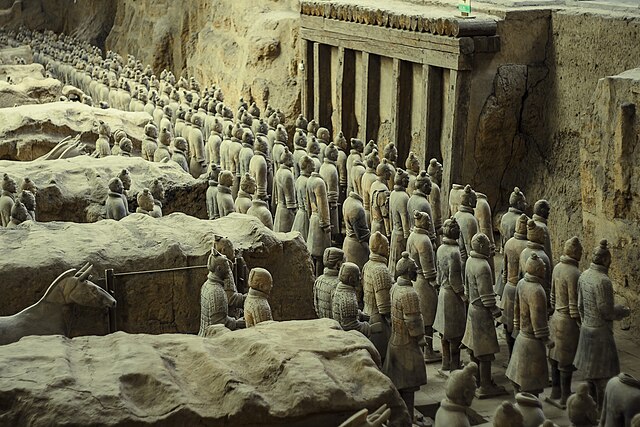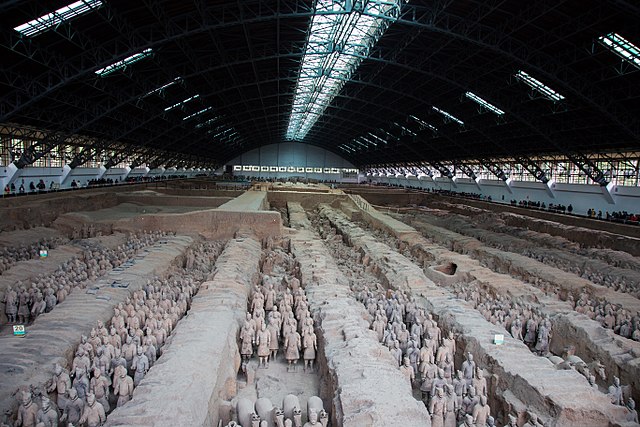The Partition of India in 1947 marked a monumental and tragic moment in South Asian history, leading to the creation of two independent nations: India and Pakistan. This event not only redrew the political map of the region but also altered the lives of millions, leaving a legacy that continues to shape the subcontinent.
The significance of the Partition cannot be overstated. It was a turning point that brought an end to British colonial rule, yet it also unleashed unprecedented violence, mass migrations, and deep-seated animosities that endure to this day. Understanding the Partition is crucial for comprehending the complex relationship between India and Pakistan, as well as the broader socio-political dynamics of South Asia.
In this article, we will delve into the following topics:
- Historical Background: A look at pre-independence India and the factors leading to the demand for a separate Muslim nation.
- The Partition Plan: Details of the British-proposed Partition plan and its impact on various regions and communities.
- Partition Violence: Accounts of the widespread violence and its long-term effects on both nations.
- Creation of India and Pakistan: The process and challenges of forming two independent countries, and the roles of leaders like Gandhi, Jinnah, and Nehru.
- Aftermath of Partition: The social, political, and economic consequences, including migrations and ongoing tensions.
- Commemorating the Partition: How the Partition is remembered and its impact on national identities, as well as efforts towards reconciliation.
Join us as we explore these facets to gain a deeper understanding of the birth of two nations and the enduring legacy of the Partition of India.
Historical Background
Before delving into the Partition of India, it is essential to understand the context of pre-independence India, a vast and diverse region under British colonial rule. Comprising various ethnicities, languages, and religions, British India was a mosaic of cultures, but also a hotbed of socio-political tensions.
Description of Pre-Independence India
Pre-independence India was a land of stark contrasts. On one hand, it was a cradle of ancient civilizations, rich in cultural and intellectual heritage. On the other hand, it was a country grappling with colonial exploitation and socio-economic disparities. The British Raj, established after the Indian Rebellion of 1857, governed India with an iron fist, exploiting its resources and people.
During British rule, India was divided into British-administered provinces and princely states ruled by local monarchs under British suzerainty. The administration was characterized by a rigid hierarchy, with the British at the top and Indians at various lower rungs based on their caste, religion, and socio-economic status.
Factors Leading to the Demand for a Separate Muslim Nation
Several factors contributed to the demand for a separate Muslim nation, ultimately leading to the creation of Pakistan. Key among them were:
- Religious Identity: The Indian subcontinent was home to a large Muslim population, constituting about 25% of the total population. Over time, Muslims began to feel marginalized in a Hindu-majority country, fearing that their religious, cultural, and political rights would not be safeguarded.
- Political Representation: The All-India Muslim League, founded in 1906, advocated for the political rights of Muslims. Leaders like Muhammad Ali Jinnah emphasized the need for a separate nation to ensure adequate political representation and protection of Muslim interests.
- Economic Concerns: Economic disparities and competition for resources intensified communal tensions. Muslims, particularly in urban centers, felt that they were at an economic disadvantage compared to their Hindu counterparts.
Role of British Colonialism in Exacerbating Religious Tensions
British colonial policies played a significant role in exacerbating religious tensions in India. The strategy of “divide and rule”, employed by the British, deepened communal divides:
- Electoral Policies: The introduction of separate electorates for Muslims and Hindus in the early 20th century institutionalized communal identities and fostered political divisions.
- Administrative Decisions: British administrators often played one community against the other to maintain control, further entrenching religious divisions.
- Economic Exploitation: The British economic policies led to widespread poverty and unemployment, which fueled communal strife as different communities competed for limited resources.
The culmination of these factors created a volatile environment, setting the stage for the eventual Partition of India. Understanding this historical background is crucial for comprehending the complex and tragic events that followed.
The Partition Plan
The Partition of India was a monumental event that reshaped the subcontinent, leading to the creation of two independent nations: India and Pakistan. This section delves into the intricacies of the Partition plan proposed by the British, its impact on various regions and communities, and the controversies and criticisms that surrounded it.
Details of the Partition Plan Proposed by the British
In an effort to address the growing demands for independence and the mounting communal tensions, the British government put forth the Mountbatten Plan on June 3, 1947. Named after the last Viceroy of India, Lord Louis Mountbatten, the plan laid out the framework for the division of British India into two separate dominions: India and Pakistan.
The key elements of the Partition plan included:
- Geographic Division: The plan proposed the division of British India into Hindu-majority India and Muslim-majority Pakistan. Pakistan was to be further divided into two geographically non-contiguous regions: West Pakistan (modern-day Pakistan) and East Pakistan (modern-day Bangladesh).
- Boundary Demarcation: The boundaries of the new nations were to be drawn by a Boundary Commission chaired by Sir Cyril Radcliffe. The Commission had the daunting task of demarcating borders based on religious majorities, while also considering economic and administrative factors.
- Transfer of Power: The plan outlined the transfer of power from the British to the new dominions, set to take place on August 15, 1947. This rapid timeline was intended to expedite the process and minimize unrest.
Impact on Different Regions and Communities
The implementation of the Partition plan had far-reaching consequences for various regions and communities across the subcontinent:
- Punjab and Bengal: These two provinces were among the most affected, as they were divided between India and Pakistan. The division led to mass migrations, with Hindus and Sikhs moving to India, and Muslims migrating to Pakistan.
- Sindh and Baluchistan: In regions like Sindh and Baluchistan, the Partition disrupted local economies and social structures, causing significant upheaval.
- Minority Communities: Religious minorities in both new nations faced persecution and violence, leading to widespread displacement and loss of life.
The impact of the Partition was profound, resulting in one of the largest migrations in human history, with an estimated 10-15 million people displaced and hundreds of thousands killed in communal violence.
Controversies and Criticisms Surrounding the Plan
The Partition plan was not without its controversies and criticisms:
- Hasty Implementation: The rapid timeline for the transfer of power left little time for an orderly and peaceful transition, exacerbating communal tensions and violence.
- Arbitrary Boundaries: The boundaries drawn by the Radcliffe Commission were seen as arbitrary and ill-informed, failing to account for the complexities of local demographics and geography.
- Lack of Adequate Preparation: The British authorities were criticized for their lack of adequate preparation and planning for the massive migrations and humanitarian crisis that ensued.
The legacy of the Partition plan is a subject of ongoing debate and reflection. While it achieved the goal of creating two independent nations, it did so at an immense human cost, leaving deep scars and unresolved conflicts that continue to shape the region’s history and politics.
Partition Violence
The Partition of India in 1947 was not just a political division; it unleashed a tidal wave of horrific violence and bloodshed that left an indelible mark on the histories of both India and Pakistan. This section explores accounts of the widespread violence, the causes and perpetrators behind it, and the long-term effects that continue to resonate to this day.
Accounts of the Widespread Violence and Bloodshed During the Partition
The violence that erupted during the Partition was unprecedented in its scale and brutality. Eyewitness accounts and historical records paint a grim picture of the chaos:
- Mass Killings: Entire villages were massacred, with death toll estimates ranging from 200,000 to 2 million people. The violence was not confined to any single region but was widespread across Punjab, Bengal, and other areas.
- Sexual Violence: Women were particularly vulnerable during the Partition. Reports of mass rapes, abductions, and forced conversions were rampant, with an estimated 75,000 to 100,000 women being victimized.
- Communal Riots: Hindu, Muslim, and Sikh communities, once living in relative harmony, turned against each other in brutal communal riots. Cities like Amritsar, Lahore, and Delhi became epicenters of this inter-communal violence.
Causes and Perpetrators of the Violence
Several factors contributed to the eruption of violence during the Partition:
- Communal Tensions: Decades of communal tensions between Hindus, Muslims, and Sikhs were exacerbated by the impending division. The fear of being a religious minority in the new nations fueled animosity and violence.
- Political Manipulation: Political leaders and local authorities often manipulated communal sentiments for their gain. In some cases, they incited violence to ensure demographic majorities in their regions.
- Breakdown of Law and Order: The rapid withdrawal of British troops and the lack of an effective policing mechanism led to a complete breakdown of law and order, allowing mobs to commit atrocities with impunity.
The perpetrators of the violence were often ordinary citizens, driven by fear, hatred, and a desire for revenge. However, there were also instances where organized groups and militias played a significant role in orchestrating the violence.
Long-term Effects of the Violence on Both Nations
The long-term effects of the Partition violence have been profound and far-reaching:
- Trauma and Displacement: The violence led to one of the largest forced migrations in human history, with an estimated 10-15 million people displaced. The trauma of losing homes, families, and communities has had lasting psychological impacts on survivors and their descendants.
- Communal Divisions: The violence entrenched communal divisions, fostering an environment of suspicion and hostility between India and Pakistan. These divisions have manifested in recurrent communal riots and conflicts over the decades.
- Geopolitical Tensions: The legacy of Partition violence has contributed to ongoing geopolitical tensions between India and Pakistan. The two nations have fought multiple wars and continue to have strained relations, particularly over the disputed region of Kashmir.
The violence of Partition serves as a somber reminder of the destructive potential of communal hatred and the importance of fostering unity and understanding. As both nations continue to grapple with the legacy of Partition, efforts towards reconciliation and peace remain crucial for building a more harmonious future.
Creation of India and Pakistan
The creation of India and Pakistan in 1947 was a monumental event that reshaped the subcontinent, marking the end of British colonial rule and the beginning of a new era for millions. This section delves into the intricate process of dividing the two nations, the formidable challenges faced, and the pivotal roles played by leaders like Gandhi, Jinnah, and Nehru.
Process of Dividing the Two Nations
The process of Partition was complex and fraught with difficulties. The British government, eager to withdraw from India, hastily devised a plan to divide the country along religious lines:
- Mountbatten Plan: The final plan, known as the Mountbatten Plan, was announced on June 3, 1947. It proposed the division of British India into two independent dominions – India and Pakistan – to be implemented by August 15, 1947.
- Radcliffe Line: The boundaries of the new nations were drawn by Sir Cyril Radcliffe, a British lawyer with no prior experience in India. The Radcliffe Line, hastily demarcated, split the provinces of Punjab and Bengal, leading to confusion and conflict.
- Princely States: Over 500 princely states were given the choice to join either India or Pakistan or remain independent. Most opted to accede to one of the two new nations, though some, like Kashmir, became sources of enduring conflict.
Challenges Faced in Creating Two Independent Countries
The birth of India and Pakistan was accompanied by a myriad of challenges:
- Mass Migration: The Partition triggered one of the largest mass migrations in history. An estimated 10-15 million people crossed borders to join their chosen nation, leading to immense human suffering and loss of life.
- Violence and Riots: The communal violence that erupted during the Partition claimed hundreds of thousands of lives and left a legacy of hatred and mistrust between the two nations.
- Economic Disruptions: The abrupt division disrupted trade, industry, and agriculture. Both nations faced economic challenges, including the distribution of assets and resources.
- Administrative Challenges: Establishing new governments and administrative structures was a daunting task. Both nations had to build their political, legal, and social institutions from the ground up.
Role of Leaders Like Gandhi, Jinnah, and Nehru in the Creation of India and Pakistan
The roles of key leaders were instrumental in shaping the destinies of India and Pakistan:
- Mahatma Gandhi: Gandhi, the leader of the Indian independence movement, advocated for a unified India and opposed the Partition. His vision of non-violence and communal harmony, though not realized in his lifetime, continues to inspire.
- Mohammad Ali Jinnah: Jinnah, the leader of the All India Muslim League, was a staunch advocate for the creation of Pakistan. His insistence on a separate Muslim nation was driven by fears of marginalization in a Hindu-majority India.
- Jawaharlal Nehru: Nehru, a prominent leader of the Indian National Congress and the first Prime Minister of independent India, played a crucial role in shaping modern India. He was committed to building a secular and democratic nation.
The divergent visions and political strategies of these leaders ultimately led to the creation of two separate nations. Their legacies, marked by both achievements and controversies, continue to influence the political and social landscapes of India and Pakistan.
The creation of India and Pakistan was a watershed moment in history, marked by both triumph and tragedy. While the challenges were immense, the resilience and determination of the people laid the foundations for two sovereign nations that continue to evolve and strive for progress.
Aftermath of Partition
The Partition of India in 1947 was not just a political event; it was a seismic shift that had profound social, political, and economic repercussions. This section explores the multifaceted aftermath of the Partition, including the mass migrations and displacements, as well as the enduring tensions and conflicts between India and Pakistan.
Social, Political, and Economic Consequences of the Partition
The Partition left indelible marks on the social, political, and economic fabric of both India and Pakistan:
- Social Consequences: The division led to the disintegration of centuries-old communities. Families were torn apart, and the social fabric of regions like Punjab and Bengal was irreparably damaged. The trauma of violence and displacement haunted generations, leaving scars that are still visible today.
- Political Consequences: The newly formed nations had to quickly establish governance structures. India adopted a secular, democratic framework under the leadership of Jawaharlal Nehru, while Pakistan, under Muhammad Ali Jinnah, aimed to build a nation rooted in Islamic principles. The political ideologies of both countries have evolved, often in divergent directions.
- Economic Consequences: The economic ramifications were severe. Partition disrupted trade routes, severed economic ties, and led to the massive redistribution of assets. Both nations faced economic instability, with Pakistan struggling to build infrastructure and India grappling with integrating princely states and managing refugees.
Migrations and Displacement of Millions of People
The human cost of Partition was staggering. The mass migrations resulted in one of the largest and most tragic displacements in history:
- Scale of Migration: An estimated 10-15 million people crossed borders, seeking refuge in their newly designated homeland. Hindus and Sikhs moved to India, while Muslims relocated to Pakistan. The migration was chaotic and often violent.
- Refugee Camps: The influx of refugees overwhelmed both nations. Makeshift camps sprang up, struggling to provide basic necessities. Disease, malnutrition, and lack of shelter were rampant issues. The governments of India and Pakistan faced immense challenges in rehabilitating these displaced populations.
- Personal Accounts: Eyewitness accounts and personal stories reveal the depth of human suffering. Families were separated, properties were lost, and lives were shattered. The oral histories collected from survivors provide poignant insights into the harrowing experiences faced during this tumultuous period.
Continuing Tensions and Conflicts Between India and Pakistan
The legacy of Partition has been a long-standing source of tension between India and Pakistan, manifesting in various forms:
- Territorial Disputes: The most significant and enduring conflict has been over the region of Kashmir. Both nations claim the territory in full, leading to multiple wars and ongoing skirmishes.
- Military Conflicts: India and Pakistan have fought three major wars since Partition (1947-48, 1965, and 1971), along with numerous smaller conflicts and standoffs. These military engagements have further strained relations and fueled mutual distrust.
- Nuclear Rivalry: Both nations have developed nuclear arsenals, adding a dangerous dimension to their rivalry. The nuclear capabilities of India and Pakistan have raised global concerns about the potential for a catastrophic conflict in the region.
- Diplomatic Efforts: Despite the hostilities, there have been efforts to foster peace and reconciliation. Diplomatic dialogues, confidence-building measures, and people-to-people exchanges have been initiated at various times, though with limited success.
The aftermath of the Partition of India is a complex and multifaceted story of human resilience, political maneuvering, and enduring conflict. Understanding this history is crucial for fostering a future of peace and cooperation between India and Pakistan, and for acknowledging the shared heritage and experiences of their peoples.
Commemorating the Partition
The Partition of India is a pivotal event in the histories of both India and Pakistan, and its commemoration is marked by a mix of sorrow, reflection, and hope. This section delves into the various ways Partition is remembered, its impact on national identities and collective memory, and the ongoing efforts towards reconciliation and peace between the two nations.
Ways in Which the Partition is Remembered and Commemorated in India and Pakistan
The commemoration of Partition takes many forms in both countries, reflecting the deep and complex emotions associated with this historic event:
- Memorials and Museums: Both India and Pakistan have established memorials and museums to honor the memories of those who suffered during Partition. For instance, the Partition Museum in Amritsar, India, serves as a poignant reminder of the human cost of the division.
- Literature and Films: The trauma and experiences of Partition have been extensively captured in literature and films. Works like Khushwant Singh’s Train to Pakistan and Salman Rushdie’s Midnight’s Children offer profound insights into the impact of Partition. Movies such as Garam Hava and Earth further explore the human stories behind the historical event.
- Public Commemorations: Anniversaries of Partition are marked by public events, discussions, and remembrance ceremonies. These events often feature speeches, exhibitions, and cultural performances that pay tribute to the resilience and suffering of the people affected.
Impact of the Partition on National Identities and Collective Memory
The Partition has had a lasting impact on the national identities and collective memories of both India and Pakistan:
- National Identity: For India, Partition underscored the importance of secularism and unity in diversity. For Pakistan, it reinforced the vision of a separate Muslim homeland. These foundational values continue to shape the national identities of both countries.
- Collective Memory: The collective memory of Partition is complex and multifaceted. It encompasses both the pain of displacement and the pride in the resilience of the people. Oral histories, family stories, and community narratives play a crucial role in preserving these memories.
- Educational Curricula: The way Partition is taught in schools significantly influences collective memory. In India, the focus is often on the tragedy and the lessons of unity, while in Pakistan, the emphasis is on the creation of a separate nation for Muslims. These differing narratives shape the perceptions of younger generations.
Efforts Towards Reconciliation and Peace Between the Two Nations
Despite the historical animosities, there have been numerous efforts to foster reconciliation and peace between India and Pakistan:
- Track II Diplomacy: Non-governmental dialogues, known as Track II diplomacy, have played a crucial role in building bridges. These include academic exchanges, business forums, and cultural collaborations that bring people from both countries together.
- Cultural Exchanges: Art, music, and sports have been powerful tools for reconciliation. Programs like the Aman Ki Asha (Hope for Peace) initiative promote cultural exchanges and people-to-people contact.
- Peace Initiatives: Various peace initiatives, such as the South Asian Voices platform, aim to address common challenges and promote dialogue. These efforts, although often facing setbacks, continue to strive for a more peaceful future.
- Commemorative Events: Joint commemorative events, where people from both nations come together to remember the shared history of Partition, are increasingly becoming common. These events foster mutual understanding and empathy.
The commemoration of the Partition of India is a testament to the enduring human spirit and the quest for peace and reconciliation. By understanding and honoring this shared history, India and Pakistan can continue to work towards a future marked by unity and mutual respect.
Conclusion
The Partition of India stands as a momentous and tragic chapter in the histories of both India and Pakistan. Its reverberations are felt even today, influencing the socio-political and cultural landscapes of both nations.
Reflection on the Lasting Impact of the Partition of India
The legacy of Partition is profound and multifaceted. It resulted in the largest mass migration in human history, leaving indelible scars on the collective psyche of both nations. The ensuing violence and displacement created deep-rooted animosities that continue to affect bilateral relations.
| Aspect | Impact |
| Socio-economic | Displacement of millions, loss of property, and economic instability |
| Political | Creation of two new nations, ongoing territorial disputes |
| Psychological | Trauma and generational suffering, identity crises |
| Cultural | Rich cultural exchanges and a shared history marred by division |
Lessons to Be Learned from This Tragic Event
The Partition of India offers several poignant lessons:
- Importance of Unity: The Partition underscores the need for unity and mutual respect in a diverse society.
- Value of Dialogue: Open communication and dialogue are crucial in resolving conflicts and preventing violence.
- Human Cost of Division: The human suffering caused by Partition serves as a reminder of the devastating impact of political and religious divisions.
Final Thoughts and Call to Action
As we reflect on the Partition of India, it is essential to foster a spirit of reconciliation and understanding between India and Pakistan. Both nations share a rich cultural heritage and history, and it is through mutual respect and cooperation that they can move towards a more peaceful future.
Let us honor the memories of those who suffered during Partition by promoting unity and understanding. By learning from the past, we can build a future where both nations coexist harmoniously, embracing their shared history and common goals.
For further reading and insights, consider exploring resources such as the Partition Museum and the Aman Ki Asha initiative.





